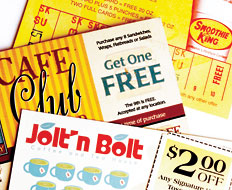Consumers are visiting quick serves less frequently these days, and restaurants are desperate to secure some customer loyalty to help offset traffic declines. But too many chains use buy-nine-get-the-10th-free punch cards to try to win customers’ loyalty—and they’ve got it all wrong.
Punch cards and similar transaction-based promotions may seem simple and convenient, but using them not only causes quick serves to miss out on valuable opportunities, but also works against their efforts to foster profitable, brand-building customer loyalty.
That’s because these tactics are generic, one-dimensional, and self-interested.
Generic Loyalty Tactics Don’t Build Brands
The default loyalty tactic is the punch card. According to the “Consumer Loyalty Study” conducted by First Data Competitive Intelligence last April, 50 percent of consumers who were members of fast food rewards programs indicated the program used punch cards. The stacks of punch cards that accumulate in people’s wallets only serve to make the stores they came from seem generic and interchangeable.
It’s no surprise, then, that these tactics don’t work. That First Data study also found that only 4 percent of fast food rewards program members indicated their membership was very influential in their choice of which restaurant to visit.
A loyalty program should give people compelling reasons to choose your restaurant by positioning and differentiating your brand. It should be a vehicle through which a brand communicates its uniqueness and delivers differentiating benefits.
The Little Black Book program from apparel retailer White House | Black Market, for example, is designed to resemble a socialite’s little black book. It makes members feel like they’re part of an inner circle by offering exclusive invitations and special offers.
Instead of thoughtlessly copying competitors and defaulting to category conventions, a loyalty program should be considered a brand touchpoint that creates just as much of an impact as advertising or customer service—and should be designed accordingly.
Loyalty Programs Should Involve More Than Discounts
Punch cards and other transaction-based discounting programs are really nothing more than one-off tactics with limited long-term value. Because so many quick serves offer these types of discounts, consumers no longer place much value on them. The rising tide of consumer expectations necessitates that companies develop more innovative programs.
In fact, some customers have become trained by chains with so-called loyalty programs to have a sense of entitlement to rewards. And because these kinds of programs are usually conceived as promotions separate and distinct from other aspects of the customer experience, they can detract from and devalue the experience by focusing on price and free food.
If planned and executed appropriately, though, loyalty programs can facilitate relationships that are valued by customers and companies alike. The key is to utilize them to get to know customers personally and to engage in dialogues with them.
For larger chains, this might involve setting up a technology infrastructure to profile and segment customers and then provide targeted offerings. For smaller ones, it can be as simple as collecting customer contact information so they can be reached through e-mail or social media.
“We have a more empowered and educated consumer, and we have the mechanism to listen to and engage in real time the voice of that customer,” says Ernan Roman, founder and principal of Ernan Roman Direct Marketing, a customer-relationship marketing consultancy. “Let’s turn the thinking around and recognize that at the beginning of a strategy, the first step is to get the voice, or the wisdom, of the customer in a disciplined way and use that to drive the rules of engagement.”
By actively seeking out customer input and feedback, chains can learn which rewards and benefits are most valued. Instead of offering discounts that have become table stakes, quick serves might discover they would achieve better results by offering different levels of service, exclusive offers and experiences, or early access to upcoming new products or promotions.
Fast Feeders Should Be More Loyal to Customers
Quick serves have a real opportunity to stand out by turning the concept of loyalty on its head. Instead of focusing on how to increase customer loyalty, companies should identify ways to be more loyal to their customers.
They should offer real benefits and appreciation for their customers’ loyalty. Going out of the way to serve people, holding the line on prices, and taking the time to thank customers personally are just a few ideas for doing so.
David Murphy, copresident and director of brand innovation at the advertising agency Barrie D’Rozario Murphy, encourages companies to “get close to your best customers. Offer them real economic and emotional benefits. They are most likely to buy and most likely to talk up the brand.”
Indeed, true loyalty is usually reciprocated. Customers express their loyalty not only through continued patronage, but also through referrals and advocacy. By rethinking your stance on loyalty, you can turn your loyal customers into brand ambassadors.
Loyalty programs can produce more than incremental visits. Programs that facilitate a mutually beneficial relationship between customer and company will give you a sustainable competitive advantage.












